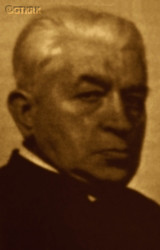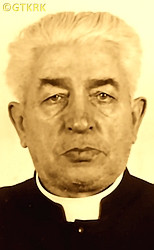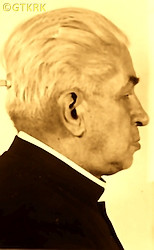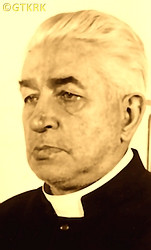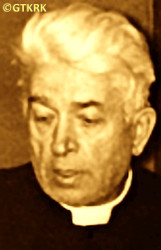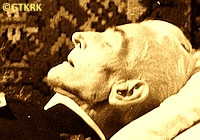Roman Catholic
St Sigismund parish
05-507 Słomczyn
85 Wiślana Str.
Konstancin deanery
Warsaw archdiocese, Poland
full list:
displayClick to display full list

searchClick to search full list by categories
wyświetlKliknij by wyświetlić pełną listę po polsku

szukajKliknij by przeszukać listę wg kategorii po polsku

Martyrology of the clergy — Poland
XX century (1914 – 1989)
personal data
surname
BRZYCKI
forename(s)
Vitus Modest (pl. Wit Modest)
function
diocesan priest
creed
Latin (Roman Catholic) Church RCmore on
en.wikipedia.org
[access: 2014.09.21]
diocese / province
Cracow archdiocesemore on
en.wikipedia.org
[access: 2013.05.19]
date and place
of death
10.10.1954

Krakówtoday: Kraków city pov., Lesser Poland voiv., Poland
more on
en.wikipedia.org
[access: 2021.06.07]
details of death
Arrested 17.11.1952 by Russian–controlled Polish commi‐nazi security forces UB.
Repeatedly tortured.
Accused of spying for the West (falsely, as a result of the torture–induced testimony of another priest).
On 21‐26.01.1953, at the show trial of employees of Kraków Curia — during which the accused were smeared as „a gang of traitors, spies and outcasts”, „hotbed of reaction linked to espionage and subversion centers” — on 27.01.1953 sentenced to 15 years in prison (three of accused Commie‐Nazis sentenced to death, later changing the sentence to life imprisonment).
Jailed in Montelupich Str in Kraków, Rawicz and Warsaw–Mokotów prisons.
On 09.03.1954 released on parole.
Perished soon after not recovering from torture.
cause of death
torment
perpetrators
Russians / Poles
sites and events
Warsaw (Mokotów)Click to display the description, RawiczClick to display the description, Trial of 21‐26.01.1953Click to display the description, Cracow (Montelupich)Click to display the description, Ribbentrop‐MolotovClick to display the description, Pius XI's encyclicalsClick to display the description
date and place
of birth
15.06.1887

Lvivtoday: Lviv urban hrom., Lviv rai., Lviv obl., Ukraine
more on
en.wikipedia.org
[access: 2022.01.16]
presbyter (holy orders)
ordination
02.07.1911

positions held
from 1945
notary — Krakówtoday: Kraków city pov., Lesser Poland voiv., Poland
more on
en.wikipedia.org
[access: 2021.06.07] ⋄ Metropolitan Curia ⋄ Kraków RC archdiocese
from 1939
parish priest — KrakówZwierzyniec district
today: Kraków city pov., Lesser Poland voiv., Poland
more on
en.wikipedia.org
[access: 2021.06.07] ⋄ Most Holy Savior RC parish ⋄ Kraków Ideanery name
today: Lesser Poland voiv., Poland RC deanery — also: chaplain of the chapel of Daughters of Divine Love Congregation's house in Wola Justowska
1924 – 1939
parish priest — Hałcnówtoday: district of Bielsko‐Biała, Bielsko‐Biała city pov., Silesia voiv., Poland
more on
en.wikipedia.org
[access: 2021.12.18] ⋄ Visitation of the Blessed Virgin Mary RC parish ⋄ Biała Krakowskatoday: district of Bielsko‐Biała, Bielsko‐Biała city pov., Silesia voiv., Poland
more on
en.wikipedia.org
[access: 2021.12.18] RC deanery
vicar — Wadowicetoday: Wadowice gm., Wadowice pov., Lesser Poland voiv., Poland
more on
en.wikipedia.org
[access: 2021.12.18] ⋄ Presentation of the Blessed Virgin Mary RC parish ⋄ Wadowicetoday: Wadowice gm., Wadowice pov., Lesser Poland voiv., Poland
more on
en.wikipedia.org
[access: 2021.12.18] RC deanery
c. 1921 – c. 1922
vicar — Wiśniowatoday: Wiśniowa gm., Myślenice pov., Lesser Poland voiv., Poland
more on
en.wikipedia.org
[access: 2021.12.18] ⋄ St Martin the Bishop and Confessor RC parish ⋄ Myślenicetoday: Myślenice gm., Myślenice pov., Lesser Poland voiv., Poland
more on
en.wikipedia.org
[access: 2021.06.07] RC deanery
c. 1919 – c. 1921
curatus/rector/expositus — Kłajtoday: Kłaj gm., Wieliczka pov., Lesser Poland voiv., Poland
more on
en.wikipedia.org
[access: 2021.12.18] ⋄ RC church ⋄ Niepołomicetoday: Niepołomice gm., Wieliczka pov., Lesser Poland voiv., Poland
more on
en.wikipedia.org
[access: 2021.06.07], Ten Thousands of Saint Martyrs RC parish ⋄ Niepołomicetoday: Niepołomice gm., Wieliczka pov., Lesser Poland voiv., Poland
more on
en.wikipedia.org
[access: 2021.06.07] RC deanery
c. 1918 – c. 1919
vicar — Ruszczatoday: part of Kraków, Kraków city pov., Lesser Poland voiv., Poland
more on
en.wikipedia.org
[access: 2021.06.07] ⋄ St Gregory the Great the Pope and Confessor RC parish ⋄ Bolechowicetoday: Zabierzów gm., Kraków pov., Lesser Poland voiv., Poland
more on
en.wikipedia.org
[access: 2021.06.07] RC deanery
c. 1915 – c. 1917
vicar — Liszkitoday: Liszki gm., Kraków pov., Lesser Poland voiv., Poland
more on
en.wikipedia.org
[access: 2021.12.18] ⋄ St Nicholas the Bishop and Confessor RC parish ⋄ Czernichówtoday: Czernichów gm., Kraków pov., Lesser Poland voiv., Poland
more on
en.wikipedia.org
[access: 2021.06.07] RC deanery
c. 1911 – c. 1915
vicar — Jaworznotoday: Jaworzno city pov., Silesia voiv., Poland
more on
en.wikipedia.org
[access: 2021.04.01] ⋄ St Adalbert the Bishop and Martyr and St Catherine Virgin and Martyr RC parish ⋄ Nowa Góratoday: Krzeszowice gm., Kraków pov., Lesser Poland voiv., Poland
more on
en.wikipedia.org
[access: 2021.06.07] RC deanery
till 1911
student — Krakówtoday: Kraków city pov., Lesser Poland voiv., Poland
more on
en.wikipedia.org
[access: 2021.06.07] ⋄ philosophy and theology, Theological Seminary ⋄ Kraków RC archdiocese
sites and events
descriptions
Warsaw (Mokotów): Prison and detention centre in Warsaw on Rakowiecka Str. Used by Germans during German occupation 1939‐1945 to held thousands of Poles. In 1945‐1956 thousands of Polish independence activists were held there by the Polish Commie‐Nazi branch of Russian NKVD/KGB police. Hundreds of Poles were executed. (more on: pl.wikipedia.orgClick to attempt to display webpage
[access: 2013.08.17])
Rawicz: Prison, founded in 1819‐1821, in place of the Franciscan Friars Minor's monastery, which was liquidated by the Prussian occupation authorities. During the World War II, during the German occupation of 1939‐1945, the German Germ. Zuchthaus (Eng. heavy prison), intended for men sentenced to long‐term imprisonment and penal camp sentences, levied mainly by the Germ. Warthegau (Eng. Wartha region) occupation courts. A large part of the prisoners were next transported from there to German concentration camps. After the end of the military operations of World War II, the prison was managed by the Commie‐Nazi authorities of the Russian prl republic. Many activists of the Polish clandestine independence underground were detained there, including soldiers of the Home Army AK. Political prisoners were finally released in 1956. (more on: pl.wikipedia.orgClick to attempt to display webpage
[access: 2013.08.17])
Trial of 21‐26.01.1953: A show trial of 4 priests from Cracow Metropolitan Curia (one, Fr Joseph Fudali, was excluded due to a state of health after tortures in prison) and 3 civilians accused of made‐up charges of treason and collaboration with Vatican. Three of the accused, including Fr Joseph Lelito, Commie‐Nazi court sentenced to death, and the remaining four to long‐terms imprisonment. Shameful and murderous role was played out by Polish „luminaries”, 53 „intellectuals” (among them Wisława Szymborska, future Nobel laureate, Sławomir Mrożek, Anne Świrszczyńska, and many others) who in a resolution the Union of Polish Writers in Cracow condemned the sentenced victims. Resolution i.a. stated: „We express absolute condemnation of the traitors to the Homeland who, taking advantage of their spiritual positions […] practiced — for American money — espionage and sabotage. We condemn those dignitaries from the higher church hierarchy who supported anti‐Polish machinations and […] destroyed valuable cultural monuments […] We commit ourselves in our work to take up current problems of the fight for socialism even more aggressively and insightfully than before and to stigmatize the enemies of the nation more sharply”. Fr Fudali perished in prison, Fr Wit Brzuski, tortured, soon after release. (more on: pl.wikipedia.orgClick to attempt to display webpage
[access: 2014.11.28])
Cracow (Montelupich): Cracow penal prison, during occupation run by the Germans — from 28.02.1941 by Germ. Geheime Staatspolizei (Eng. Secret State Police, known as Gestapo. In 1940‐1944 Germans jailed there approx. 50,000 prisoners, mainly Poles and Jews. Some of them were transported to KL Auschwitz concentration camp, some were executed. After cease in war effort the prison was used by UB — a Polish unit of Russian NKVD — as a prison for Polish independence resistance fighters, some of which were subsequently sent to prisons and slave labour camps in Russia. (more on: en.wikipedia.orgClick to attempt to display webpage
[access: 2014.10.31])
Ribbentrop‐Molotov: Genocidal Russian‐German alliance pact between Russian leader Joseph Stalin and German leader Adolf Hitler signed on 23.08.1939 in Moscow by respective foreign ministers, Mr. Vyacheslav Molotov for Russia and Joachim von Ribbentrop for Germany. The pact sanctioned and was the direct cause of joint Russian and German invasion of Poland and the outbreak of the World War II in 09.1939. In a political sense, the pact was an attempt to restore the status quo ante before 1914, with one exception, namely the „commercial” exchange of the so‐called „Kingdom of Poland”, which in 1914 was part of the Russian Empire, fore Eastern Galicia (today's western Ukraine), in 1914 belonging to the Austro‐Hungarian Empire. Galicia, including Lviv, was to be taken over by the Russians, the „Kingdom of Poland” — under the name of the General Governorate — Germany. The resultant „war was one of the greatest calamities and dramas of humanity in history, for two atheistic and anti‐Christian ideologies — national and international socialism — rejected God and His fifth Decalogue commandment: Thou shall not kill!” (Abp Stanislav Gądecki, 01.09.2019). The decisions taken — backed up by the betrayal of the formal allies of Poland, France and Germany, which on 12.09.1939, at a joint conference in Abbeville, decided not to provide aid to attacked Poland and not to take military action against Germany (a clear breach of treaty obligations with Poland) — were on 28.09.1939 slightly altered and made more precise when a treaty on „German‐Russian boundaries and friendship” was agreed by the same murderous signatories. One of its findings was establishment of spheres of influence in Central and Eastern Europe and in consequence IV partition of Poland. In one of its secret annexes agreed, that: „the Signatories will not tolerate on its respective territories any Polish propaganda that affects the territory of the other Side. On their respective territories they will suppress all such propaganda and inform each other of the measures taken to accomplish it”. The agreements resulted in a series of meeting between two genocidal organization representing both sides — German Gestapo and Russian NKVD when coordination of efforts to exterminate Polish intelligentsia and Polish leading classes (in Germany called «Intelligenzaktion», in Russia took the form of Katyń massacres) where discussed. Resulted in deaths of hundreds of thousands of Polish intelligentsia, including thousands of priests presented here, and tens of millions of ordinary people,. The results of this Russian‐German pact lasted till 1989 and are still in evidence even today. (more on: en.wikipedia.orgClick to attempt to display webpage
[access: 2015.09.30])
Pius XI's encyclicals: Facing the creation of two totalitarian systems in Europe, which seemed to compete with each other, though there were more similarities than contradictions between them, Pope Pius XI issued in 03.1937 (within 5 days) two encyclicals. In the „Mit brennender Sorge” (Eng. „With Burning Concern”) published on 14.03.1938, condemned the national socialism prevailing in Germany. The Pope wrote: „Whoever, following the old Germanic‐pre‐Christian beliefs, puts various impersonal fate in the place of a personal God, denies the wisdom of God and Providence […], whoever exalts earthly values: race or nation, or state, or state system, representatives of state power or other fundamental values of human society, […] and makes them the highest standard of all values, including religious ones, and idolizes them, this one […] is far from true faith in God and from a worldview corresponding to such faith”. On 19.03.1937, published „Divini Redemptoris” (Eng. „Divine Redeemer”), in which criticized Russian communism, dialectical materialism and the class struggle theory. The Pope wrote: „Communism deprives man of freedom, and therefore the spiritual basis of all life norms. It deprives the human person of all his dignity and any moral support with which he could resist the onslaught of blind passions […] This is the new gospel that Bolshevik and godless communism preaches as a message of salvation and redemption of humanity”… Pius XI demanded that the established human law be subjected to the natural law of God , recommended the implementation of the ideal of a Christian state and society, and called on Catholics to resist. Two years later, National Socialist Germany and Communist Russia came together and started World War II. (more on: www.vatican.vaClick to attempt to display webpage
[access: 2023.05.28], www.vatican.vaClick to attempt to display webpage
[access: 2023.05.28])
sources
personal:
krakowianie1939-56.mhk.plClick to attempt to display webpage
[access: 2013.08.10], pl.wikipedia.orgClick to attempt to display webpage
[access: 2021.12.19]
original images:
blogmedia24.plClick to attempt to display webpage
[access: 2014.11.28], ipn.gov.plClick to attempt to display webpage
[access: 2021.12.18], ipn.gov.plClick to attempt to display webpage
[access: 2021.12.18], ipn.gov.plClick to attempt to display webpage
[access: 2021.12.18], ipn.gov.plClick to attempt to display webpage
[access: 2021.12.18], billiongraves.comClick to attempt to display webpage
[access: 2021.12.18]
LETTER to CUSTODIAN/ADMINISTRATOR
If you have an Email client on your communicator/computer — such as Mozilla Thunderbird, Windows Mail or Microsoft Outlook, described at WikipediaPatrz:
en.wikipedia.org, among others — try the link below, please:
LETTER to CUSTODIAN/ADMINISTRATORClick and try to call your own Email client
If however you do not run such a client or the above link is not active please send an email to the Custodian/Administrator using your account — in your customary email/correspondence engine — at the following address:

giving the following as the subject:
MARTYROLOGY: BRZYCKI Vitus Modest
To return to the biography press below:
 Click to return to biography
Click to return to biography








